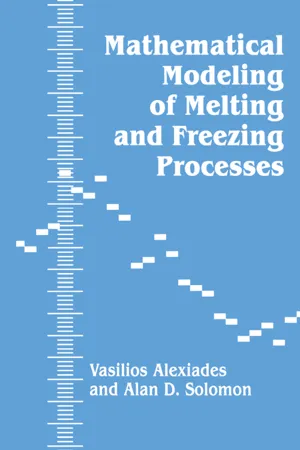
- 340 pages
- English
- ePUB (mobile friendly)
- Available on iOS & Android
Mathematical Modeling Of Melting And Freezing Processes
About This Book
This reference book presents mathematical models of melting and solidification processes that are the key to the effective performance of latent heat thermal energy storage systems (LHTES), utilized in a wide range of heat transfer and industrial applications. This topic has spurred a growth in research into LHTES applications in energy conservation and utilization, space station power systems, and thermal protection of electronic equipment in hostile environments. Further, interest in mathematical modeling has increased with the speread of high powered computers used in most industrial and academic settings. In two sections, the book first describes modeling of phase change processes and then describes applications for LHTES. It is aimed at graduate students, researchers, and practicing engineers in heat transfer, materials processing, multiphase systems, energy conservation, metallurgy, microelectronics, and cryosurgery.
Frequently asked questions
Information
Table of contents
- Cover
- Half Title
- Title Page
- Copyright Page
- Table of Contents
- Preface
- 1. PROBLEM FORMULATION
- 2. PROBLEMS WITH EXPLICIT SOLUTIONS
- 3. ANALYTICAL APPROXIMATIONS
- 4. NUMERICAL METHODS – THE ENTHALPY FORMULATION
- 5. APPLYING THE TECHNIQUES OF MODELING
- BIBLIOGRAPHY
- INDEX